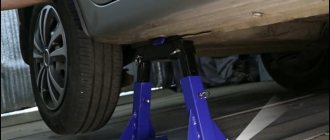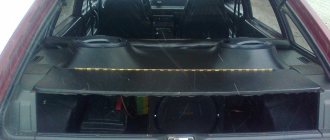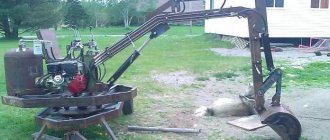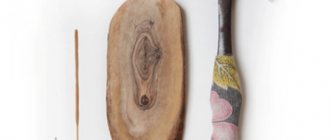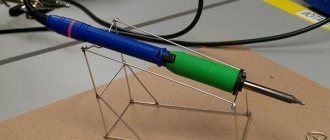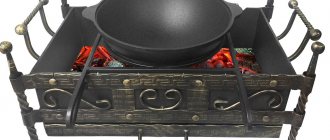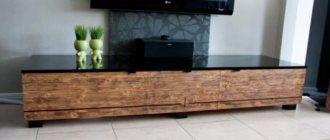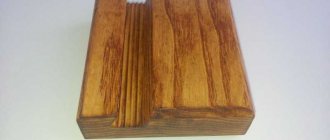What can you use to make a car stand with your own hands?
A do-it-yourself car stand is made from metal water pipes and other pipes. It is very reliable and allows you to adjust the height.
When repairing a car yourself, it is important that it does not roll away, because this can lead to serious injuries, damage to equipment or the vehicle itself. Therefore, supports are used for many repair work. And an inexpensive solution would be to make your own car stand.
Design
A do-it-yourself or purchased car stand has a simple design. It is equipped with a tripod for installation on the floor, a mount that holds the car by the sills. Sometimes equipped with a height adjustment mechanism. But this lift is not used instead of a jack. Therefore, the car is first lifted with a jack, and then supports are used.
DIY car stand
What was measured?
- Fixation step.
The minimum value through which the height of the stand can be adjusted. The smaller it is, the more convenient it is to use the stand, since it can be installed in almost any position of the jack. - Rollover arm.
This is the distance from the vertical axis of the rack to the line connecting the edges of the platforms of adjacent supports. Determines the stability of the rack. The larger the leverage, the better. - The width of the area in contact with the car threshold.
The larger it is, the less likely it is to damage the threshold. - The total area of the support
determines the pressure that the support exerts on the surface. The smaller the area, the greater the pressure - such supports can “sink” in soft soil. - Comparison of the landing dimensions of the support and the retractable element.
The smaller the difference, the less backlash and safer operation of the rack. - Real minimum overhang.
Indicates the minimum height that the rack can provide without the use of a locking device. - The thickness of the walls of the support, retractable element and legs.
It speaks about the strength of the structure: the more, the better. - Weight.
Indirectly speaks about the strength of the structure: the more, the better.
The results are below. Tested samples are listed in alphabetical order.
| Approximate price 570 ₽ Load capacity 2 t Stated 277–365 mm Folding. The legs are noticeably loose. But the gaps between the support and the sliding element are minimal in our sample. Can be used |
| Approximate price 710₽ Load capacity 2 t Declared 250–360 mm Unfoldable. The safety catch is not secured by anything and may get lost. The production is very rough. A rubber gasket is provided to protect the threshold of the machine. The width of the platform and the support area are the maximum in the sample. The play is quite large. The fixation step is the largest. There are better products |
| Approximate price 1300 ₽ Load capacity 2 tons Stated 275–420 mm Folding design looks loose. Stability is the worst in the sample. The area under the threshold is small. Bad stand, don't buy |
| Approximate price 1550 ₽ Load capacity 2 t Declared 270–360 mm With a folding support, the central leg does not actually touch the ground. Stability is the worst in the sample. The total score is second place from the bottom. Do not buy |
| Approximate price 1900 ₽ Load capacity 3 tons Declared 295–438 mm Massive welded structure. Braces from GOST corners. The fixation step is small. Overall, it’s a good balanced product that easily outperforms all competitors. We must take it |
| Approximate price 1350 ₽ Load capacity 3 tons Stated 275–365 mm The design of the folding stand is loose, although the welding is neat. The stability is low, the width of the platform is small. Can be used |
| Approximate price 900 ₽ Load capacity 2 tons Stated 275–420 mm Poor support: sharp legs without support platforms will instantly sink into any surface. The fixation step is the smallest. The width of the area in contact with the threshold is the lowest - this is bad. The design has more play than the others. Do not buy |
| Approximate price 2560 ₽ Load capacity 2 t Declared 275–420 mm Fixation step - the smallest in the sample. High stability. The area under the threshold is very small. There is a lot of play. The price is high, but the quality is mediocre: on one of the stands, the support plate fell off when pressed with a finger. Risk your life? Do not buy |
The tested stands can be divided into folding and rigid. It makes sense for any car enthusiast who can independently change a tire on the road to carry a folding one. Inexpensive, uncomplicated and compact safety net is more convenient and reliable than improvised means (for example, a brick or a spare tire that is pushed under the car).
The racks, which look like welded pyramids with a triangle or rectangle at the base, are much more solid, stronger and heavier than “clamshells”. Their scope of application is repairs in the garage. It’s all the more offensive to see their knife-like legs, as if specially designed for damaging asphalt and self-leveling floors, as well as poor penetration of the support platforms and narrow, unreliable platforms under the threshold.
All racks withstood the declared static load. Although this is not the only important thing. Increased backlash, poor-quality welding, low stability indicate that this support is unreliable and it is dangerous to rely on it. A car like this can fall, and it’s good if only the threshold or chassis parts are damaged, and not the person lying under it.
The Delo Tekhniki supports won an absolute victory. All other racks are significantly behind.
SAFETY
When installing the rack, do not rush to remove the jack: this is just an additional insurance. It is enough if the rack takes on part of the load.
Remember: in most cars, the reinforced sill area is designed only for a jack. Therefore, try to distribute the pressure from the support to the threshold by placing a small board.
It is a pity that only one manufacturer (Art. VTS20) took care of the integrity of the car threshold by using a rubber pad.
- Seven useful gizmos for motorists for the winter - here.
- We advise you to make a protective mesh yourself or install a model radiator protection.
- In the Za Rulem store you can pick up car boxes for SUVs, snow chains for crossovers and many useful little things for any car.
Types of stands
Do-it-yourself car safety stands come in several types. They are divided into regulated and unregulated. The supports differ in the material from which they are made.
Car safety stands
A DIY wooden stand for a car is the simplest type of tripod. It is usually unregulated, but has sufficient reliability. Metal supports are often made or purchased. They are usually adjustable and fit both cars and trucks.
Unregulated
Non-adjustable tripods are cheap. This DIY wooden car stand is very quick to make. They are also made from other materials.
Adjustable
Adjustable stands for the car, purchased or made by yourself, are equipped with a mechanism that allows you to change the lifting height. It is very convenient to use. But ready-made devices are expensive. And making them is more difficult than ordinary supports. Metal or iron and wood are used for manufacturing.
Adjustable car stands
Such supports are used in garage auto repair shops. You can also use them to repair your car if the work is complex.
Rack for horizontal storage of wheels
Tires that are not separated from the rims can be stored horizontally.
The manufacture of shelves for such placement is distinguished by the possibility of using sheet material as a raw material and a smaller height, which is especially important in limited space. The sequence of work is similar to assembling the rack. The difference is that the longitudinal slats are replaced with sheet material, and the height between the shelves corresponds to the width of one or two wheels, depending on the design solution. To save space, such products are often wall-mounted or hanging.
DIY stand - ready-made diagrams
You can make a car stand with your own hands. Drawings and diagrams are available online. But you can draw the layout yourself.
As you can see from the photo of do-it-yourself car stands, they usually create simple tripods made of wood without adjustment. They are used for repair and maintenance of passenger cars. The supports are light but durable.
But there are also schemes of more complex structures that allow you to adjust the height. Their creation usually requires experience working with metal and takes a little longer. But this DIY car stand is suitable for complex repairs and heavy vehicles.
Manufacturing instructions
A do-it-yourself car stand is made from metal water pipes and other pipes. It is very reliable and allows you to adjust the height. For manufacturing you will need the following materials:
Manufacturing instructions
Do-it-yourself car stand like this:
After assembly, the support can be painted or covered with other materials. It can easily support a passenger car and a small truck or SUV.
Source
Safety stand made of wheel rims for cars
Hello everyone, in this article I want to tell you how you can make a useful craft, namely a safety stand for a car from a simple, unnecessary wheel rim. So, we take a car rim and cut off the front edge with a grinder; from the photo I think it will be more clear which one it is))).
We also need a square profile measuring 60x60 and 50x50. We cut 25 cm from one and the other profile, then you need to drill holes.
In a 60x60 profile, we retreat 2 - 3 centimeters from the edge and drill a hole with a diameter of 15 mm, I selected the diameter of the hole for the bolt, almost any bolt will do, the main thing is that the length is more than 6 cm.
In a 50x50 profile, we drill holes every 3 cm, more often, less often, there is no particular connection to the size, but we drill as it will be more convenient for you.
Now we need to make a square hole in our disk in the middle, to fit the size of our profile 60x60. We apply, mark and cut out with a grinder.
Next, we insert our profile into the cut-out square hole, insert it until it rests against the table, it will be clearer in the photo, and only after that we scald it around.
On one side of the 50x50 profile I welded a pulley to provide a platform for supporting the car.
I welded a chain to the bolt, and screwed the chain itself to the disk, this is so that the bolt does not go anywhere))).
To give the stand the appearance of spray painting it, first, of course, primed it.
This turned out to be a useful, and most importantly necessary, fake. Now you can crawl under the car without fear.
All the best to you and good luck to everyone.
Author; Glavnyiy-Mehanik Sumy, Ukraine
Main stages of work
The first step is to make a mount for the grinder. To do this, the author cuts off two metal plates, drills holes in them and attaches them to the gearbox housing using bolts.
After this, you will need to cut another plate and weld it to the first two plates.
Next, the author welds a steel strip to the resulting fastening, the end of which is fixed to the body of the angle grinder using a clamp.
Do-it-yourself homemade safety stand for a car from a wheel rim
You insert them into each other, then into a vice. Drill holes approximately every 3 cm to insert the bolt. Clean the disc and pipe blanks from rust using sandpaper or a drill attachment. We place the pipe in a standing position in the center of the disk, mark a square mark, and cut it out with a grinder. We insert a 6x6 pipe into the center of the disk (into the sawn hole) and weld it to the disk. We insert a 5x5 cm pipe inside, place a roller on top of the pipe and weld it. We paint all our parts and dry them. We weld a piece of chain to the bolt on one side, and screw the other side to the hole in the disk with any bolt. Our entire design is ready, we can begin testing.
This post may contain affiliate links. This means I earn a small commission from links used at no additional cost to you. See my privacy policy for more information.
How to properly store tires on rims: standing or lying down
However, practical motorists have long realized that it is better to have both sets of tires, winter and summer, on rims. So that, when the time comes, you can simply swap one wheel for another and pump them up to the required pressure. Any male neighbor can do this. An essential point that makes the life of a car lady easier, by the way.
Useful advice Before the seasonal crowds in tire shops occur, it is more than advisable to check the wheels. It's worth taking the time to take a set of wheels there. An inspection, which includes checking for defects and balancing, will protect you from troubles on the road and save life and health.
We have already decided that assembled wheels are more convenient to use. This also applies to ease of storage.
- The wheels are laid one on top of the other on a flat floor, but no more than 4 pieces. High stacks that are stored for many months will destroy the lower tires.
- Or hung on wide, strong slings or ropes from hooks on the ceiling or metal rods on the walls. They are specially equipped with garages or sheds. Suitable for underground storage, where the temperature does not drop below zero degrees and there is no humidity.
Hanging car shoes on disks in a dry shed or garage is preferable. This prevents damage to the main material of the tire - rubber and ensures good ventilation. And the main weight of the wheel is taken by the metal disk.
Packaging should only be done in ventilated cases or cellophane with holes. Condensation, which inevitably forms in a dense bag, will cover the stamped discs with rust.
Please note: A metal garage is not the best place to store winter tires in summer. It heats up inside like an oven. Since winter tires are softer than summer tires, when heated above 50 degrees Celsius, they become completely unusable. There is a risk of losing your wheels completely or discovering that they are defective later, already on the track, which is fraught with unpleasant consequences.
Types of stands
Do-it-yourself car safety stands come in several types. They are divided into regulated and unregulated. The supports differ in the material from which they are made.
Car safety stands
A DIY wooden stand for a car is the simplest type of tripod. It is usually unregulated, but has sufficient reliability. Metal supports are often made or purchased. They are usually adjustable and fit both cars and trucks.
Unregulated
Non-adjustable tripods are cheap. This DIY wooden car stand is very quick to make. They are also made from other materials.
Adjustable
Adjustable stands for the car, purchased or made by yourself, are equipped with a mechanism that allows you to change the lifting height. It is very convenient to use. But ready-made devices are expensive. And making them is more difficult than ordinary supports. Metal or iron and wood are used for manufacturing.
Adjustable car stands
Such supports are used in garage auto repair shops. You can also use them to repair your car if the work is complex.
Is it possible to keep rubber in a metal structure?
It is also allowed to store tires not in permanent garages, but in metal and unheated structures. Only here you should monitor the temperature and humidity levels. If the garage is not heated and there is a constant temperature of -30 degrees, then there is a risk that the tires will deteriorate. The situation will be exactly the same if high humidity prevails in the room.
High humidity in the garage will be caused by a soil floor and poor ventilation.
The very principle of storing tires at least permanently. although in a metal garage they are no different from each other. Here you also need to comply with all norms and GOSTs, monitor sudden temperature changes, prevent tires from coming into contact with chemicals, and properly organize shelves, racks or hooks.
DIY stand - ready-made diagrams
You can make a car stand with your own hands. Drawings and diagrams are available online. But you can draw the layout yourself.
As you can see from the photo of do-it-yourself car stands, they usually create simple tripods made of wood without adjustment. They are used for repair and maintenance of passenger cars. The supports are light but durable.
But there are also schemes of more complex structures that allow you to adjust the height. Their creation usually requires experience working with metal and takes a little longer. But this DIY car stand is suitable for complex repairs and heavy vehicles.
Installation of corrugated sheets
Installation of corrugated sheets can be done on one or both sides. Since the material is light and durable, its installation does not require much time or professional knowledge. However, it is still advisable to follow some recommendations. To fix the profile, you should use self-tapping screws. They are screwed in three directions: horizontally, vertically and diagonally. The sheet is attached through one wave to the frame. Together, the corrugated sheet creates a wave.
If the project includes a gate, it is also attached to hinges. However, the frame is manufactured separately in accordance with the overall dimensions. After the installation work of the corrugated sheeting has come to an end, you can proceed to installing the lock and fittings. In this situation, the owner independently decides which elements he will use: a latch, several locks, or structures with automatic elements.
To clearly familiarize yourself with the instructions on how to make a gate from corrugated sheets with your own hands with a wicket, it is recommended to watch the video below:
Safety stand for a car. With your own hands
This safety stand is needed in order to leave the car in a raised state after you have raised it with a jack.
For this device you will need:
First of all, cut two pieces of pipe equal in length.
Next, in a pipe with a larger diameter, use a drill to drill a hole near the end of the pipe.
It is necessary to attach a corner piece to the smaller of the pipe pieces. For ease of fastening, we suggest making a recess at the end of the pipe. It is convenient to make the recess using an angle grinder. Try to make the cut approximately in the middle of the edge.
We attach the corner piece to the pipe by welding.
Next, we place a smaller piece of pipe into a larger pipe and drill holes in 2 cm increments. These holes should coincide with each other in both pipes. To do this, fix the pipes relative to each other.
Now all that remains is to attach the larger piece of pipe with its end to the metal plate. The plate will act as a support for the entire safety post.
Thus, we have a telescopic retractable rack for fixing the car in a raised state. All that remains is to paint this homemade product and try it out.
Where is the best place to place tire racks?
It is advisable to place racks for storing wheels in your own garage away from the entrance, securing them properly on one of the walls. There the temperature is most stable, and the tires will not be subject to such changes as near the gate.
Design the rack so that the tires are 5-10 centimeters from the wall. It is advisable to move oils and other technical fluids to the opposite corner of the garage to avoid unnecessary contact with rubber.
DIY car stand
Greetings, Samodelkins!
Many of you probably have a personal car and you most likely had to independently repair your iron horse, little by little, so to speak, without fanaticism. The author of the YouTube channel “TeraFox” is no exception.
Safety precautions for hanging wheels include installing a support under the car. This rule should not be neglected in any way, and the simplest, most accessible and most importantly free method is a tree stump.
But after all, we live in the 21st century, we want something more modern, functional and no less reliable. After quite a long period of thought, the master realized that everything had long been invented before him. All you have to do is go online and choose the most suitable option.
The choice was made, the material was purchased. For this homemade product we will need two square pipes 30 by 30 and 40 by 40, wall thickness 3mm. Since there are no specific sizes, the author decides to do everything approximately, by eye, so to speak. The first step is to mark the fortieth pipe. Then we will cut off the required total length for two pieces, which in turn will also have to be cut at an angle, but closer to the edge. The parts are ready and absolutely symmetrical to each other. And now it’s the turn of the 30th pipe. It fits and exits perfectly into the fortieth pipe, therefore, the fortieth pipe can be used as a template for marking the thirtieth pipe and trim off the excess using a grinder. Out of 30 pipes we also received 2 parts. Now let's return to the 40th pipe. We need one more piece with angled edges. This is what we have at this stage. It turns out to be a kind of house; the crossbar will need to be welded to the upper sections along the edges. This is what we will do now. And everything would be fine, but there is a very small nuance in the form of a 4mm gap between the pipes. This is too much, 2mm everywhere, we need to fix it. The author found a 2 mm metal plate. It was decided to make spacers in the form of strips from it. This is the only way to reduce the gap, although if we initially took pipes 40 and 35 with a wall thickness of 2 mm, then this point could be eliminated. But still, the 35th pipe is more difficult to buy, they don’t sell it everywhere, plus a 3mm wall is still more impressive than 2mm, so that’s how it is. The gap is reduced, the movement is free, that's what we needed to get. Next, the strips must be carefully welded at points to the pipes. Using a core, we mark future holes along the edges and drill, starting with a small diameter. To make the holes coincide with each other, we hold the pipe in the pipe. We finish drilling with the tenth diameter of the drill. A bolt test shows that the idea was a success, a clear match. Using exactly the same principle, you need to make holes in the rack. And on the opposite counter there are absolutely the same manipulations. So far everything is going according to plan. Next, we disassemble the workpieces into parts and begin marking on the internal guide posts, starting from the top hole by 30mm and then repeating. A total of 4 such holes need to be drilled. So, the main part is ready, of course the stops are missing. The remainder of the 30th pipe will be used for these purposes. The parts are welded, the only thing is that we leave untouched those areas where the strut reinforcements will be located, in simple terms, gussets. Next we need a piece of 4 mm sheet. All that remains is to mark it and cut out the missing parts. The scarves are ready, positioned along the posts with an inclination relative to the surface. We immediately weld everything into place. In front of you is an old broken jack: The teeth at the base could not stand it, the lead screw was severely deformed. The reason for this breakdown was that once the author of today's homemade product raised the car too high, and it simply slid to the side, jumping off the jack and thereby damaging it. But at the moment we only need the rubber band from the top of the jack. Under the elastic band, I need to make a special base with sides. A 50 x 20mm profile pipe is perfect for this. This is what happened in the end. Now you need to make a hole in the crossbar for this base. You also need to drill a hole in the center of the base itself. And now, all the parts are ready. It's time to start assembling. And the same pin from the jack will also come into use, we’ll just correct the chamfer a little. Next, the lower part of the cross member must be strengthened using a thrust plate. To do this, we mark the same remainder of the 4 mm plate, cut it out, and then weld it. But this is not the final element of our design. Now let's put everything together and see what we ended up with. There are 4 holes in the stand and of course there are not enough latches. You can, of course, come up with something out of bolts, but perhaps not this time. We protect the tenth round timber from corrosion, cut it into 60mm pieces in the required quantity, core it and straight to the machine. And now the 4 studs are ready, all that remains is to make a chamfer. Now we need rings from cheap Chinese keychains. They are great for a new task. And how is this not a harsh keychain for a locksmith? And finally the production approached the final stage - painting. The paint is completely dry, then assembly follows. This is such an unusual stand. And of course it needs to be tested in operation. To do this, you need to move to the garage. We start by removing the cross member and placing it between the jack and the fulcrum on the stiffener, like this: Then we thread the posts through and secure them with studs. That's it, you can lower it, the stand works. Now let's raise the car higher by increasing the height of the pillars. Once secured, lower the jack. At the same time, the author noticed a displacement of the stands relative to the floor due to the support rubber. When you lift the car, it moves a little, as if sliding on an elastic band. This requires a specific clamp. Let's make a new stop with pieces of round timber on the plate.
Design features
Diagrams and design drawings for tire maintenance can satisfy any requirements of the car owner. It can be:
- racks and shelves of various configurations;
- hooks and stands;
- specialized cabinets in which you can create your own microclimate, ideal for keeping a particular set of tires in the garage.
Some of them are universal and suitable for any tire, others are highly specialized and designed for special conditions.
Racks and shelves
A rack for storing wheels in a garage gives the owner the following advantages:
- the ability to equip a rack with wheels with additional shelves designed for various tools;
- depending on the size of the garage and the amount of free space, the size and shape of the stand can be easily adjusted during assembly;
- the design has a large margin of safety at a relatively low cost.
Hooks and stands
Convenient devices for storing wheels in the garage, with the following advantages:
- easily and quickly made independently;
- take up little space and can be placed in any free corner of the garage;
- the stand, unlike a shelf or rack, can be easily moved from place to place and, in case of repair, it does not need to be dismantled or disassembled;
- materials for their manufacture are readily available and relatively cheap.
Note! Wheel hooks can be made as permanent brackets that attach to the wall, or as a removable piece that can be hung from a metal cable or rope, which is very convenient.
Specialized cabinets
If there is desire, time and money, the garage owner can equip the room with a special cabinet for storing wheels. Advantages of cabinets:
- the design does not spoil the appearance of the room;
- placed in any free space. It is not necessary to install it on the floor; you can make special fastenings and hang it on the wall;
- storing the wheels in a special cabinet will ensure that a jar of oil or other liquid that is in your garage will not accidentally be knocked over on them. This will significantly extend the life of the tires.
Wooden stands instead of a pit in the garage
brazh
Regular participant
Often there is a need to crawl under the car. For example, to change the oil. But not everyone has a hole in their garage. I don't have it either. Therefore, you must use a safe way to lift the car and secure it in this position. Climbing under a car that is only supported by jacks is very dangerous! Most often, people use special stands, as in the figure below.
The following ramps are also popular (at least in America):
But it seemed to me safer to make wooden stands for the wheels. I found the most information on this topic, again, on American sites. At the end of this post I have provided links to the most interesting articles.
Advantages of wooden stands: 1) Safety. Some people use bricks, which is not recommended at all, because... At any moment, the brick can crumble and you will merge with your favorite car. The tree, before breaking, will begin to crunch. Those. More often than not, there will be some indication that something is wrong. The likelihood that the car will slide off such stands is very low (if you follow safety precautions). 2) Easy to make stands. 3) The relative cheapness of this option.
But there are also some disadvantages: 1) You cannot remove the wheels. 2) Wooden stands take up quite a lot of space in the garage.
It is interesting to note the fact that American firefighters use approximately the same stands when they need to fix a heavy object (for example, a car). Only firefighters use separate blocks (wood cribbing) so that they can build various stands:
My version of wooden coasters looks like this:
On top I screwed 2 sheets of plywood, each 10mm thick (I had unnecessary pieces in the garage). I inserted scraps from the boards into the holes in the top of this entire structure for additional strength of the top layer. I screwed all the boards together with self-tapping screws.
The car is placed on stands like this: first the front is placed, and then the rear of the car (or vice versa). Many cars have points where you can jack up the entire front or rear at once. There are no such points on my Passat, so I first lift the front on the right side, and then on the left. The same is done with the rear. When I lift the right side, and then start to lift the left, the car’s suspension tries to “bring together” the wheels. For this reason, the stand on the side opposite to the rise begins to tilt and may tip over. Is it dangerous! Be careful and control this situation! After this, you have to return to the left side again and adjust the stand:
Be sure to use wheel chocks when lifting the car!
This is what the Passat looks like with the front end raised on stands. There is enough space to work. It's not scary to crawl under such a car.
Rules for storing car wheels
Not every car owner knows that they need to follow the rules for storing wheels, otherwise they quickly become unusable and can fail at the most inopportune moment. Different sets of tires have specific storage conditions, but general rules can also be identified, the observance of which will be relevant in any situation:
- Do not store wheels near heating or cooling devices. Significant temperature changes occur near them, which cause condensation to accumulate and deformation of the rubber.
- Make sure that the wheels are not exposed to moisture, oil or acidic liquids.
- Store tires in a cool, dry place.
- If the wheels are wrapped in film, do not forget to periodically remove and ventilate them. Otherwise, dampness will begin to accumulate inside, which will negatively affect the material in the future.
Now let's look at the individual storage features of different sets.
Summer tires
Summer tires are made from materials whose composition is different from winter tires, and accordingly, the storage conditions will be different. The peculiarity of storing summer tires is that the room temperature should be kept around 20 o, with a relative humidity level not exceeding 60%. Small deviations from these indicators are acceptable.
Winter tires
Winter tires do not tolerate high temperatures well. Therefore, beware of installing racks and fixtures for storing it in:
- rooms with high temperatures;
- places exposed to direct sunlight.
On disks
Storing wheels on disks adds additional nuances to the preservation process. The thing is that when stored vertically, the tires, under the influence of the weight of the rims, will begin to deform. This will reduce their quality of adhesion to the road surface, which can lead to an emergency situation.
It is recommended to store assembled tires in a horizontal position, on top of each other, or suspended on a rope that is threaded through the center of the disk.
Note! When storing tires for the winter, they must be well inflated. The pressure inside the wheels should be working or slightly below normal.
No disks
If you store tires separately from wheels, follow these rules:
- keep them upright;
- once a month, rotate the tire 20-180 o;
- It is allowed to store the wheels in a suspended state, stringing them on a rope or metal cable.
